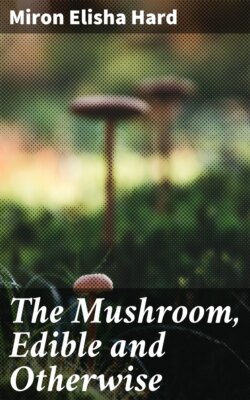Читать книгу The Mushroom, Edible and Otherwise - Miron Elisha Hard - Страница 35
На сайте Литреса книга снята с продажи.
Amanita cæsarea. Scop.
ОглавлениеTable of Contents
The Orange Amanita. Edible.
Figure 28.—Amanita cæsarea. From a drawing showing the different stages of the plant. Caps, gills, stem and collar yellow, volva white.
Photo by H. C. Beardslee.
Figure 29.—Amanita cæsarea.
The Orange Amanita is a large, attractive, and beautiful plant. I have marked it edible, but no one should eat it unless he is thoroughly acquainted with all the species of the genus Amanita, and then with great caution. It is said to have been Cæsar's favorite mushroom. The pileus is smooth, hemispherical, bell-shaped, convex, and when fully expanded nearly flat, the center somewhat elevated and the margin slightly curved downward; red or orange, fading to yellow on the margin; usually the larger and well-developed specimens have the deeper and richer color, the color being always more marked in the center of the pileus; margin distinctly striate; gills rounded at the stem end and not attached to the stem, yellow, free and straight. The color of the gills of matured plants usually is an index to the color of the spores but it is an exception in this case as the spores are white.
The stem and the flabby membranaceous collar that surrounds it toward the top are yellow like the gills, the depth of the color varying more with the size of the plant than is the case with color of the cap. Sometimes in small and inferior plants the color of both stem and gills is nearly white, and if the volva is not distinct it is difficult to distinguish it from the fly mushroom, which is very poisonous. The stem is hollow, with a soft cottony pith in the young plants.
In very young plants the edge of the collar is attached to the margin of the cap and conceals the gills, but with the upward growth of the stem and the expansion of the cap the collar separates from the margin and remains attached to the stem, where it hangs down upon it like a ruffle.
The expanded cap is usually from three to six inches broad, the stem from four to six inches long and tapering upward.
When in the button stage, the plant is ovate; and the white color of the volva, which now entirely surrounds the plant, presents an appearance much like a hen's egg in size, color, and shape. As the parts within develop, the volva ruptures in its upper part, the stem elongates and carries upward the cap, while the remains of the volva surrounds the base of the stem in the form of a cup.
When the volva first breaks at the apex, it reveals the point of the cap with its beautiful red color and in contrast with the white volva makes quite a pretty plant, but with advancing age the red or orange red fades to a yellow. In drying the specimens the red often entirely disappears. In young, as well as in old plants, the margin is often prominently marked with striations, as will be seen in Figures 28 and 29. The flesh of the plant is white but more or less stained with yellow next to the epidermis and the gills, which are of that color.
The plant grows in wet weather from July to October. It grows in thin woods and seems to prefer pine woods and sandy soil. I have found it from the south tier of counties to the north of our state. It is not, however, a common plant in Ohio.
From its several names—Cæsar's Agaric, Imperial Mushroom, Cibus Deorum, Kaiserling—one would infer that for ages it had been held in high esteem as an esculent.
Too great caution cannot be used in distinguishing it from the very poisonous fly mushroom.
